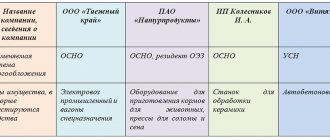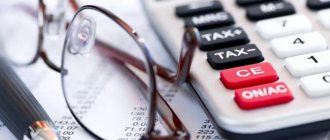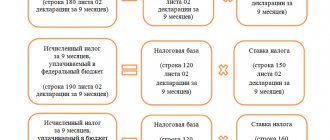Procedure for calculating excise taxes
The general scheme for calculating excise taxes is based on several basic principles:
- the tax base (TB) for each type of excisable goods (PT) is calculated separately;
- excise tax rates for calculation are taken from Art. 193 Tax Code of the Russian Federation;
- the formula for calculating the amount of excise tax (A) depends on the type of excise tax rate: for PT for which fixed (specific) rates are established:
A = NPT × SArub.,
Where:
NPT - the number or volume of sold PT in physical terms;
SArub. — excise tax rate (in rubles and kopecks per unit of measurement of PT);
- for PT for which ad valorem (interest) rates are established:
A = SPT × A% / 100%,
Where:
CPT - cost of sold PT;
CA% - excise tax rate (as a percentage of the cost).
- for PTs for which combined rates are set:
A = NPT × SArub. + SPT × A% / 100%.
The indicated formulas form the basis for the calculation of excise taxes in most situations with PT, however, in some cases, if the structure of the calculations is similar, specific indicators may be used - you can learn about this in the subsequent sections of our material.
Tax rate calculation
Line 020 indicates the DDT indicator:
- if the DDT value is negative, the sign is “0”;
- with a positive DDT value - sign “1”.
Line 030 indicates the value of the DDT indicator:
page 030 = page 050 – page 060
Line 040 indicates the value of the KDT_COMP value, equal, starting from January 1, 2022, to 0.65.
Line 050 indicates the average price of the export alternative for class 5 diesel fuel, calculated at the seaports of the Northwestern Federal District (CDTexp).
Line 060 indicates the conditional value of the average wholesale price for the sale of class 5 diesel fuel on the territory of the Russian Federation (CDTvr). Thus, for the period from January 1 to December 31, 2021, the wholesale price is set at 50,700 rubles. for 1 ton of fuel.
Line 070 indicates the value of the excise tax rate on middle distillates (ADL).
line 070 = (Excise tax rate on diesel fuel +750) – line 030 * line 040
The value of line 070 must correspond to the value of line 030 of section 2, filled in according to the type code of excisable goods “677” , reflected in line 010 .
Advance excise payments: conditions of application and calculation formula
“Excise” advance is established by clause 8 of Art. 194 of the Tax Code of the Russian Federation for producers of alcoholic and excisable alcohol-containing products (ASSP) a mandatory payment, which is an advance payment of excise tax on ASSP:
- before purchasing alcohol produced in the Russian Federation (including raw alcohol);
- before performing the operation specified in sub. 22 clause 1 art. 182 of the Tax Code of the Russian Federation.
To calculate the amount of the “excise” advance:
- NB - determined based on the total volume of alcohol purchased or transferred within the company;
- CA - determined on the date of transfer of the advance payment or on the date of provision of the bank guarantee (in the situation of exemption from the advance payment).
The actually paid “excise” advance is subject to deduction when determining the amount of excise tax on the realized ASSP.
Example
LLC "Spirtoprom" produces alcoholic products with an alcohol volume content of over 9%. According to the plan, in December 2016 the company plans to purchase 140 liters of ethyl alcohol for these purposes.
Calculation of the amount of advance “excise” payment (AAP) for December, subject to transfer to the budget in November 2016:
- NB = 140 l;
- CA = 500 rub./l;
- AAP = 140 l × 500 rub./l = 70,000 rub.
LLC "Spirtoprom" submitted a payment for the transfer of the advance in the calculated amount to the bank on November 14, 2016 - this corresponds to the deadlines established by clause 6 of Art. 204 Tax Code of the Russian Federation. At the same time, documents confirming the payment of the “excise” advance must be submitted to the tax authorities no later than November 18, 2016 (clause 7 of Article 204 of the Tax Code of the Russian Federation).
How to calculate “profitable” advance payments - read the material “Advance payments for income tax: who pays and how to calculate?”.
Who pays excise tax
Excise tax payers (Article 179 of the Tax Code of the Russian Federation) are Russian and foreign:
- individual entrepreneurs;
- organizations;
- individuals who transport goods across the border of the Customs Union.
In most cases, excise tax is paid for the following actions with goods:
- sale;
- Border crossing;
- production;
- transfer for further production;
- transfer to the person who provided the raw materials for the production of the goods;
- transfer for processing;
- transfer to an employee who leaves the company.
The obligation to pay excise tax does not always arise. Some groups of goods require payment of tax only for specific transactions: for example, producers of straight-run gasoline pay excise tax, but sellers do not.
Manufacturers are exempt from excise taxes (Article 183 of the Tax Code of the Russian Federation) if they transfer goods within the company's divisions for further production (except in some cases), if they export goods abroad, during the first sale of confiscated goods. For exemption, special conditions must be met: separate accounting of excisable and non-excise goods, bank guarantees (Articles 184, 195, 204 of the Tax Code of the Russian Federation).
Methodology for calculating excise tax in the absence of separate accounting
Keeping separate records is an important procedure that allows you to correctly calculate “excise” obligations and legally take advantage of tax benefits. The need for separate accounting arises in relation to PT with different tax rates.
If the merchant has not taken care of organizing such accounting, a special method for calculating excise taxes is used - it is as follows:
- definition of NB - a single NB is calculated for all transactions performed that are recognized as an object of excise taxation in accordance with Art. 182 of the Tax Code of the Russian Federation (NBobshch):
- applicable excise tax rate is the maximum of all applicable rates (CAmax);
- the amount of excise tax (A) is determined by the formula:
A = NBtotal ×CAmax
With this composition of the calculation formula, the taxpayer loses part of his funds, which he can save by organizing separate accounting of PT.
Let's illustrate this with an example.
Example
PivovarLux LLC produces beer without separate accounting. In December 2016, the volumes of produced and sold products were:
| Volume of beer produced, l | Proportion of alcohol in the final product,% | Excise tax rate, rub. / l | Excise tax amount, rub. | |
| if there is separate accounting | in the absence of separate accounting | |||
| 291 480 | 6,0 | 20,0 | 5 829 600 | (291,480 l + 286,370 l + 201,580 l) × 37 rub./l |
| 286 370 | 7,0 | 20,0 | 5 727 400 | |
| 201 580 | 9,0 | 37,0 | 7 458 460 | |
| Total | 19 015 460 | 28 838 910 | ||
As a result of calculations for the structure and volumes of produced and sold food products indicated in the table, the fact of the absence of separate accounting increases the amount of accrued excise tax by 51.66%.
Responsibility for non-payment of excise tax on a car
Business entities carrying out excisable transactions with cars and motorcycles that have not submitted a tax return to the Federal Tax Service within the prescribed period and have not paid the excise duty are held liable for taxation in the form of fines.
An organization/individual entrepreneur that has not submitted a declaration or submitted a document after the established deadline is obliged to pay a fine to the budget in the amount of 5% of the amount of excise tax assessed for payment on the basis of the declaration. The minimum amount of the fine established for this violation is 1,000 rubles, the maximum amount of the penalty is 30% of the amount of the accrued excise duty.
If the deadlines for payment of excise duty are violated, the Federal Tax Service has the right to collect from the taxpayer a fine in the amount of 20% of the amount of the arrears. At the same time, according to the Tax Code of the Russian Federation, the following is recognized as arrears:
- underpayment of tax (the difference between the accrued and actually paid amount of excise tax);
- the full amount of accrued excise duty in case of late payment or non-payment.
If the taxpayer repeatedly violates the deadlines for paying excise duty during the reporting month, the amount of the fine increases to 40% of the amount of arrears.
How to determine the amount to be paid to the budget when importing excisable goods
We will consider separately the methodology for determining the amount of excise duty payable when importing PT:
- for PTs subject to mandatory marking;
- PT not subject to labeling.
The amount of excise duty calculated using the methods below is paid at customs.
The product is not subject to marking
When calculating excise tax on unlabeled PT, the following methodological aspects must be taken into account:
NB - is defined as the volume (quantity) of PT in physical terms (as of the date of their reflection on account 41 “Goods”);
SA - only fixed (specific) rates (TSA) are applied, the value of which is specified in Art. 193 of the Tax Code of the Russian Federation (domestic excise rates).
Formula for calculating excise tax (A):
A = V (K) × TCA,
where V (K) is the volume or quantity of PT imported from abroad in physical terms.
The product is subject to mandatory labeling
Tobacco and alcohol products (except for beer, beer drinks, cider, poire and mead) must be labeled.
The calculation of excise obligations is carried out according to the methods described above, depending on the applied rates (clause 2 of article 186.1 of the Tax Code of the Russian Federation):
- at combined rates (for cigarettes and cigarettes);
- at fixed (specific) rates (for other imported food products).
Study the application of various tax rates using articles prepared by specialists on our website:
“Tax rate under the patent tax system”;
“What are the tax rates for personal income tax in 2014–2015?”.
Does an increase in the excise tax rate affect the methodology of “excise” calculations?
In accordance with clause 6.2.1 of the main directions of tax policy for 2015–2017 (approved by the Government of the Russian Federation on July 1, 2014), adjustments to excise tax rates are provided for in 2022. Eg:
- indexation of specific rates on tobacco products by 10%;
- an increase in the ad valorem component of the combined excise tax rate on cigarettes and cigarettes from 9% of the cost of cigarettes, calculated at maximum retail prices, to 10% of the maximum retail price.
In this case, the calculation formulas when calculating “tobacco” excise taxes will not change.
It should be noted that the methodology for calculating the amount of excise taxes when changing “excise” rates is fixed at the legislative level, therefore all the nuances that affect the final “excise” amount payable are described in the Tax Code of the Russian Federation.
For example, from 2022 the Ministry of Finance of the Russian Federation plans to increase alcohol, which is currently taxed at a zero excise rate for the production of cosmetics and household chemicals. All features of excise tax calculation (including features of the application of deductions, benefits, etc.) for this group of PT will be described in the Tax Code of the Russian Federation after the adoption of the relevant law.
For details about the “excise” plans of the Ministry of Finance of the Russian Federation, see the message “They want to impose excise taxes on alcohol for the production of cosmetics, household chemicals and medical products .
What goods are subject to excise duty?
An excise tax is an indirect federal tax that must be paid on certain goods and services. Their list is given in Art. 181 Tax Code of the Russian Federation:
- ethyl alcohol from food and non-food raw materials, including denatured, raw alcohol, distillates;
- alcohol with an ethyl alcohol content of more than 0.5%, beer, wine materials;
- cigarettes, cigars, hookah tobacco and other tobacco products;
- diesel fuel, motor oils for diesel and injection engines;
- straight-run gasoline;
- grape;
- vapes and liquids for them;
- cars and motorcycles;
- and other types of goods.
If you import goods from the list given in Art. 181 of the Tax Code of the Russian Federation, to Russia, they must pay excise taxes. Exporters (those who export excisable products from the Russian Federation) are not required to pay excise tax.
Some excisable goods are exempt from excise taxes upon import. Aviation kerosene, benzene, paraxylene, orthoxylene and petroleum raw materials fall into this category (Article 183 of the Tax Code of the Russian Federation, letters from the Ministry of Finance).
Further sales of imported excisable goods will not be subject to excise taxes.
How to check excise tax - verification method
Verification of the correctness of calculation of excise taxes is carried out by regulatory authorities, which carry out verification procedures in relation to “excise” declarations submitted by taxpayers.
Such procedures may include the following control stages:
- the correctness of determining the tax base for excise taxes;
- the correctness of the excise tax rates applied by the taxpayer;
- correct application of tax deductions for excise taxes;
- the reliability of information about the taxpayer and supporting documents (for example, the presence of a certificate for operations with straight-run gasoline);
- the correctness of calculation of the amount of excise tax at the location of separate divisions (including operations to reconcile the number of such divisions with the information available in the state register).
Find out about the methodology for checking reporting using special ratios from the articles posted on our portal:
“Control ratios for checking form 6-NDFL”;
“Control ratios of budget reporting in 2016”;
“Control ratios for 4-FSS in 2016”.


